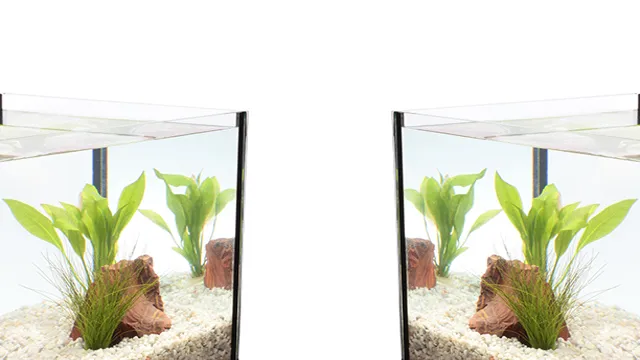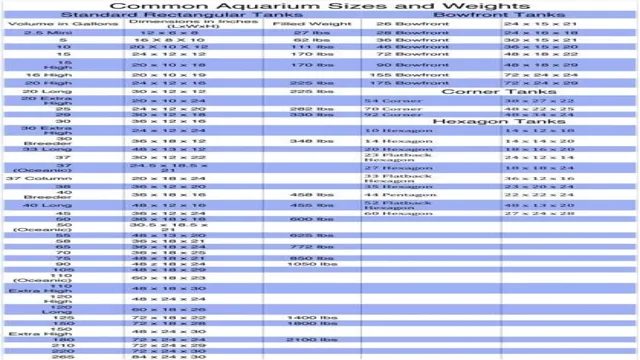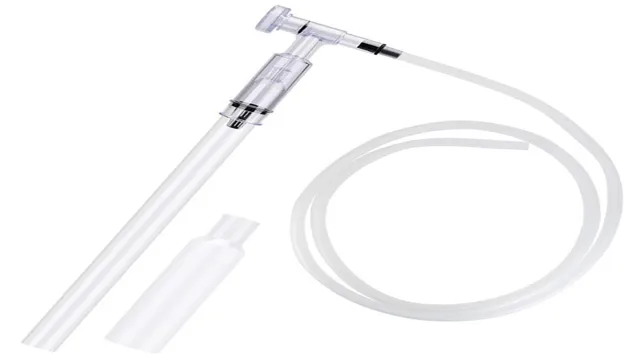How to Maintain pH Level of Water in Aquarium with Ease – Tips and Tricks

Keeping a clean and healthy environment in your aquarium is a top priority for any fish lover. While many factors play a role in maintaining a balanced ecosystem, one of the most important is pH levels. pH levels measure the acidity or alkalinity of the water, and they can range from 0 to 1
Maintaining the ideal pH level ensures your fish thrive, and your plants grow healthy and strong. But how do you achieve and maintain the optimal pH level? In this blog post, we’ll explore some tips on how you can maintain pH levels in your aquarium water, so you can enjoy a colorful, lively, and healthy underwater world right in your own home!
Understanding pH Level in Aquariums
Maintaining pH levels in aquariums is crucial for the survival and wellbeing of aquatic life. The pH level measures the acidity or alkalinity of the water, ranging from 0 to 1 A pH of 7 is considered neutral, while anything below 7 is acidic and anything above 7 is alkaline.
Most aquarium species prefer a pH range between 5 to 5, but this may vary depending on the species.
To maintain a stable pH level, regular water testing is necessary, and adjustments can be made using buffer solutions. It’s crucial to avoid sudden changes in pH levels as this can stress out fish and other aquatic life. Factors that can affect the pH level in aquariums are substrate, driftwood, and rocks, as they can release minerals that can alter the pH.
Therefore, it’s essential to research the water requirements of the species in the aquarium and adjust accordingly to avoid any adverse effects. Overall, maintaining the pH level in aquariums is crucial for the health and longevity of aquatic life, and regular testing and adjustments are necessary to keep it stable.
What is pH Level?
pH Level, Aquariums Understanding pH level in aquariums is a crucial component of maintaining a healthy aquatic environment. The pH level is a measure of how acidic or basic the water is. It is measured on a scale from 0 to 14, where 7 is considered neutral.
A pH level of less than 7 is acidic, while a level above 7 is basic. Fish and other aquatic creatures have specific pH requirements, and it is important to ensure that the pH level falls within their acceptable range. A fluctuation in pH level can have harmful effects on the aquatic life and can contribute to stress, disease, and even death.
Therefore, it is essential to monitor the pH level regularly and make adjustments as necessary. Testing kits are readily available to measure the pH level, and treatments are available to raise or lower it if needed. Maintaining proper pH level in aquariums is a key factor in keeping aquatic creatures healthy and happy.

The Importance of Optimal pH Level
Optimal pH Level in Aquariums As an aquarist, it’s important to understand the significance of maintaining an optimal pH level in your aquarium. pH level is a measure of the acidity or alkalinity of water, and it can have a serious impact on the health and well-being of fish and other aquatic creatures. The ideal pH level for most freshwater fish falls between
5 and 5, which is slightly acidic to neutral. Any fluctuations from this range can cause stress, illness, and even death.
One common cause of fluctuations in pH level is the buildup of ammonia in the water. Ammonia is a natural byproduct of fish waste, and if it’s not properly removed through regular water changes and a well-functioning filtration system, it can lead to an increase in pH level. This can create an unhealthy environment for fish and other aquatic creatures, causing them to become lethargic, develop infections, or even die.
Another factor that can impact pH level in aquariums is the use of substrate or decorations that have a high buffering capacity. These materials can release alkaline compounds into the water, causing the pH level to rise. It’s important to choose substrates and decorations that are pH-neutral or slightly acidic to maintain a healthy balance in the aquarium.
In conclusion, maintaining an optimal pH level is crucial for the health and well-being of your aquatic creatures. By monitoring ammonia levels, choosing the right substrate and decorations, and performing regular water changes and filtration maintenance, you can create a happy and healthy environment for your fish to thrive in.
Factors that Affect pH Level in Aquariums
Maintaining the correct pH level is crucial for the health of your aquarium’s inhabitants. Many factors can affect the pH level in your aquarium, such as the type of substrate, water source, and the types of plants and animals living inside the tank. One of the most common causes of pH fluctuations is the build-up of organic waste and excess food in the aquarium.
To prevent this, make sure you do not overfeed your fish and perform regular water changes. It is also necessary to test the pH level of your aquarium water regularly to ensure it stays within the ideal range for your particular species of fish and plants. If the pH level drops too low, adding an alkaline product such as baking soda can raise the pH level.
Conversely, adding a product like vinegar can lower the alkalinity if the pH level is too high. Regular monitoring and maintenance are essential for keeping a healthy pH level in your aquarium, ultimately ensuring the well-being of your aquatic friends.
Biological Waste and Decomposition
Biological Waste and Decomposition Maintaining a stable pH level is crucial for a healthy aquarium environment. Several factors can affect the pH level of your aquarium, and biological waste and decomposition are two of the most significant ones. Biological breakdown can release harmful acids and toxins, which can lower the pH level and make the water acidic.
Fish waste, uneaten food, and dead plant matter can also contribute to higher ammonia and nitrate levels, leading to an increase in pH. Besides, overfeeding and overcrowding can also worsen the situation. Thus, it’s essential to prevent overfeeding and regularly clean the aquarium to remove excess biological waste and maintain the pH level.
Note that sudden changes in pH levels can also harm fish and other aquatic life. Therefore, it’s best to monitor the pH level and take necessary steps to keep it stable and healthy for your aquatic pets.
Substrate and Decorations
When it comes to maintaining a healthy aquarium for your fish, the pH level plays a crucial role. It’s no secret that different fish species require different pH levels to thrive, and several factors can affect the pH level in your aquarium. One such factor is the substrate and decorations you use in your tank.
Certain substrates, such as crushed coral or limestone, can increase the pH level, while others like peat moss or driftwood can lower it. Similarly, decorations like rocks or shells can have an impact on pH levels based on their mineral content. Therefore, it’s essential to research the needs of your specific fish and choose substrate and decorations accordingly to maintain ideal pH levels.
An imbalance in pH levels can lead to stress, illness, and even death in your fish. A healthy pH level is vital in supporting the biological and chemical processes that occur in your aquarium, ensuring a thriving environment for your fish to call home.
Water Source and Quality
Water Source and Quality Maintaining the pH level in an aquarium is crucial for the health and well-being of the aquatic animals. Several factors can affect the pH level in an aquarium, including the water source and quality. Aquarium owners must pay close attention to the water source and quality they use to fill their tanks.
If the water source has high alkalinity, then it may increase the pH level in the aquarium, making it more alkaline. Conversely, if the water source has low alkalinity, then it may lower the pH level of the aquarium, making it more acidic. Additionally, different brands of water conditioner and aquarium substrate can also affect the pH level.
It is important to test the water regularly and make adjustments to maintain the desired pH level. By ensuring a proper water source and quality, aquarium owners can maintain a healthy environment for their aquatic animals.
Measuring pH Level in Aquariums
Maintaining the proper pH level in your aquarium is crucial to the health and well-being of your fish and plants. The pH level measures the acidity or alkalinity of the water and can affect the ability of fish to breathe and plants to absorb nutrients. To maintain a healthy pH level in your aquarium, start by testing the water regularly using a pH test kit.
The ideal pH level for most fish species is between 5 and
If the pH level is too high, you can lower it by adding a pH-lowering product or mixing in some distilled water. If the pH level is too low, you can raise it by adding a pH-raising product or using a substrate that contains calcium carbonate. Remember to make adjustments gradually, as sudden changes in pH levels can shock your fish and harm them.
By maintaining a balanced pH level, you can ensure that your aquarium remains a safe and healthy environment for your aquatic pets.
Testing Kits and Tools
When it comes to maintaining a healthy aquarium, measuring the pH level is crucial. This is because the pH level indicates the acidity or alkalinity of the water, and certain fish and plants thrive best in specific pH ranges. Testing kits and tools, such as pH strips or electronic pH meters, can help accurately measure the pH level in your aquarium.
pH strips are easy to use – simply dip the strip in the water and match the color to the chart provided. Electronic pH meters, on the other hand, provide precise readings but may require calibration and can be more expensive. It’s important to check the pH level regularly and make adjustments as necessary to keep your aquatic pets and plants happy and healthy.
Remember, each fish and plant has different pH preferences, so it’s essential to research their individual needs before adding them to your aquarium.
How to Use Testing Kits and Tools
Aquariums, pH level, testing kits, Keeping an aquarium can be a delightful and fulfilling hobby. However, it requires a bit of effort and knowledge, especially when it comes to measuring the pH level in your aquarium. Test kits can be your best friend in this aspect as they allow you to measure the pH level and ensure that your fish and plants are thriving in the right conditions.
The most commonly used kit is a chemical test kit, which involves adding a solution to a sample of aquarium water. The kit will then change color to indicate the pH level. Digital testing tools are also available and are more accurate than chemical kits.
They come in two types- probes that can be permanently installed in the aquarium or portable handheld devices. Regardless of which kit you choose, make sure to follow the instructions carefully and regularly check the pH level. With proper care and attention, your aquarium will be a thriving ecosystem that you and your fish can enjoy.
Maintaining the Right pH Level in Aquariums
Maintaining the right pH level of water in your aquarium is crucial for your fish’s health and survival. pH levels are measured on a scale of 0-14, with 7 being neutral. Most freshwater fish thrive in a pH range between
5-5, while some saltwater species prefer a more alkaline environment. To maintain the proper pH, you can start by testing the water regularly using a pH testing kit.
If your pH levels fall out of the desired range, there are a few strategies you can take. You can use additives such as pH buffers or adjusters to raise or lower the pH levels gradually. But be careful not to make quick and drastic changes as this can stress out your fish.
Natural methods such as adding driftwood, peat moss, or Indian almond leaves can also help lower the pH levels. Finally, make sure to avoid overfeeding your fish, as excessive food can contribute to an imbalance in the water’s pH level. Following these simple steps will keep your aquarium’s pH level in check and provide a healthy environment for your aquatic pets.
Regular Water Changes
Maintaining the right pH level is crucial for the well-being of fish in an aquarium. One important factor in maintaining the pH level is regular water changes. These changes help to remove excess waste and chemicals from the water that can alter the pH level.
The frequency of water changes will depend on the size of the aquarium, the number of fish, and the amount of food being given. It is often recommended to change between 10-20% of the water every week, but this can vary. If the pH level begins to fluctuate, it may be necessary to increase the frequency of water changes.
Over time, consistent water changes will help to keep the pH level stable and ensure a healthy environment for aquatic life. So, remember to make water changes a regular part of your aquarium maintenance routine!
Using pH-Lowering or -Raising Products
Maintaining the right pH level in your aquarium is essential for the health and well-being of your aquatic pets. pH is the measure of the acidity or alkalinity of the water, and different fish species require different pH levels. If the pH level is too high or too low, it can stress out your fish and even lead to diseases.
To maintain the ideal pH level in your aquarium, you can use pH-lowering or -raising products. These products are readily available in pet stores and are simple to use. However, it’s essential to use them sparingly and in the right amounts to avoid sudden changes in pH levels that can shock your fish.
It’s also crucial to monitor the pH levels regularly using a testing kit. By maintaining the right pH balance, you’ll ensure that your fish live in a healthy and thriving environment.
Avoiding Sudden pH Level Changes
Maintaining the right pH level in aquariums is vital for the health and well-being of your aquatic pets. But sudden pH level changes can be incredibly harmful and even deadly for your fish. Avoiding these abrupt changes is crucial, and it all comes down to being mindful of the water you add to your aquarium.
Tap water often contains chemicals that can alter the pH levels, so you should always treat the water with a good quality conditioner to neutralize any harmful chemicals. Additionally, when adding new fish or plants to your aquarium, it’s essential to acclimate them gradually to avoid sudden pH changes. By slowly adding small amounts of water from your aquarium to their bag over time, you can acclimate them safely and still keep your pH level stable.
Keeping your aquarium healthy requires a bit of effort and attention, but it’s well worth it when you get to enjoy the vibrant, colorful fish and plants that call it home.
Conclusion and Tips for Success
Maintaining the pH level of your aquarium water may seem daunting, but it’s really just a matter of regular monitoring and simple adjustments. Testing your water often allows you to catch any sudden changes and take corrective measures before they become problematic for your aquatic pets. Whether it’s through water changes, using pH-increasing or decreasing additives, or simply adjusting the type of decor in your tank, keeping a balanced pH level in your aquarium can be easily achieved.
Remember, happy fish make for happy owners – so don’t neglect your pH levels and keep your aquatic friends swimming in comfort and style!”
Summary of Key Points
Maintaining the right pH level in aquariums is crucial for the health of your fish and aquatic plants. The pH level of water determines whether it is acidic, neutral, or alkaline, and different species of fish and plants thrive in different pH ranges. For example, most freshwater aquariums should have a pH between
5 and 5, while saltwater aquariums typically require a pH between 8 and
An incorrect pH level can stress and harm your aquatic pets, making them more susceptible to diseases and other health problems. To maintain the right pH level in your aquarium, you may need to adjust the water by adding chemicals or natural substances, such as baking soda or driftwood.
Additionally, regularly checking the pH level of your aquarium and making adjustments as needed can ensure that your aquatic friends remain healthy and happy.
Additional Tips for Maintaining pH Level in Aquariums
Maintaining the pH level in aquariums is crucial for the well-being of aquatic creatures. To ensure the water in your aquarium remains in the right pH range, regular testing is vital. While there are commercial test kits available, they’re often expensive.
A cheaper solution is litmus paper, which is available in most drug stores. Additionally, you can avoid extreme changes in pH by making small, gradual water changes instead of drastic ones. By accomplishing this, you can prevent the water from becoming too acidic or alkaline, which can be harmful to fish.
Another tip is to select fish species that are compatible with your aquarium’s existing pH level. Lastly, it is essential to avoid overcrowding in the aquarium because too many organisms can create an imbalance in the pH level, which can be challenging to maintain. By following these tips, you can maintain the pH level in your aquarium, providing a healthy and comfortable environment for your aquatic creatures.
FAQs
What is pH level and why is it important in aquariums?
pH level measures the acidity or alkalinity of water. In aquariums, maintaining a proper pH level is important for the health and well-being of aquatic life.
What is the ideal pH level for most aquariums?
The ideal pH level for most aquariums is between 6.5 and 7.5.
How can I test the pH level of my aquarium water?
You can test the pH level of your aquarium water by using a pH testing kit that is available at most pet stores.
What are some ways to maintain a proper pH level in my aquarium?
Some ways to maintain a proper pH level in your aquarium include regular water changes, adding pH buffer solutions, and using natural substances like driftwood and peat moss to lower pH levels.
What happens if the pH level in my aquarium is too high or too low?
If the pH level in your aquarium is too high or too low, it can stress or even harm your aquatic life, making them more susceptible to disease and illness.
Can tap water affect the pH level in my aquarium?
Yes, tap water can have a significant impact on the pH level in your aquarium, as it may contain high levels of minerals and chemicals that can raise pH levels.
Are there any specific types of fish that require a certain pH level?
Yes, some species of fish, such as discus and angelfish, require a lower pH level than other species. It’s important to research the specific needs of your aquatic life to ensure a healthy environment.






